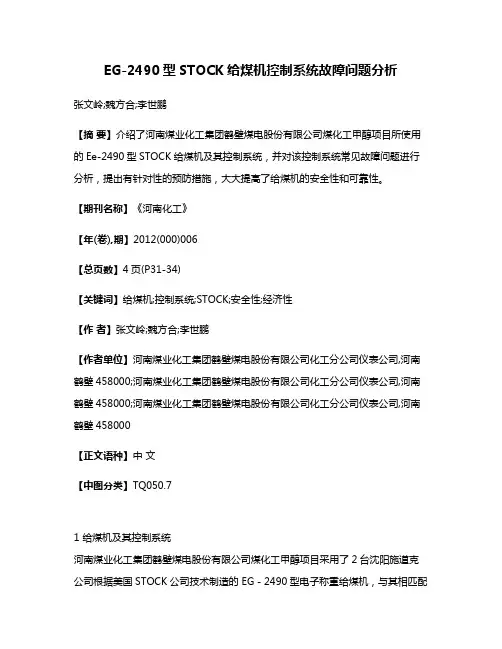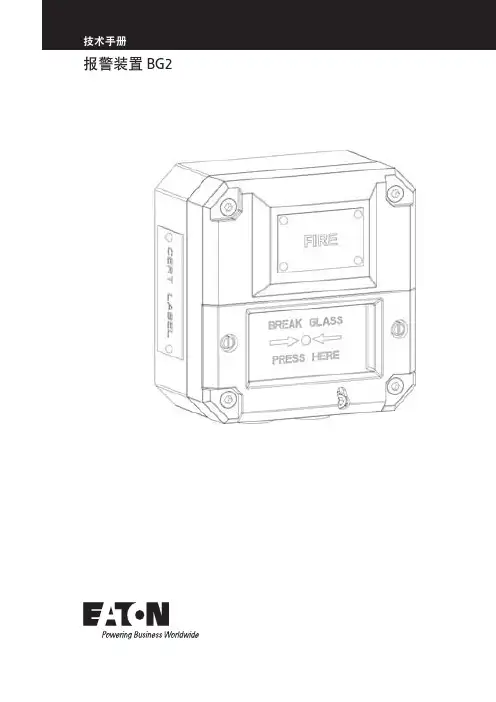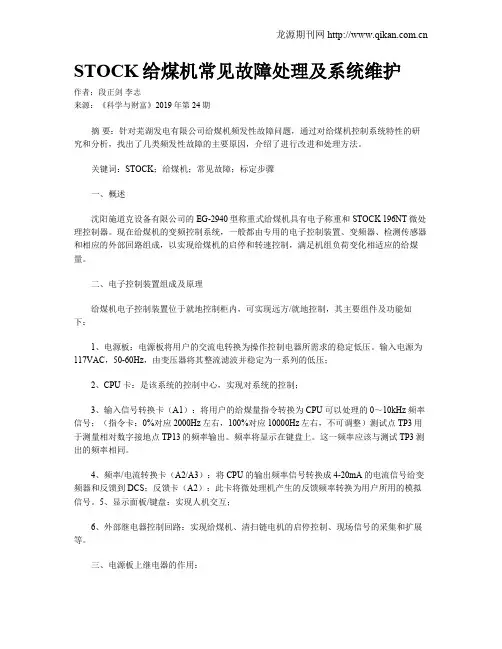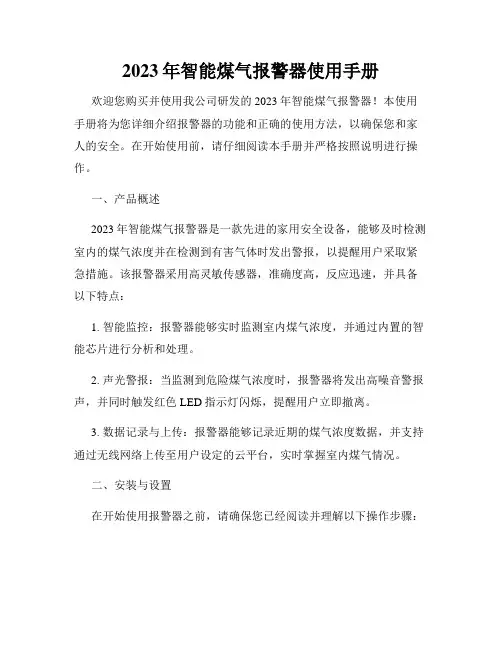STOCK堵煤报警器中文说明书
- 格式:pdf
- 大小:131.38 KB
- 文档页数:22


EC-5120 时钟显示型120防区报警器使用说明书1系统简介本系统是时钟显示型120防区家用/商用防盗报警系统,功能实用,性价比高、配置齐全、操作简单。
系统采用微电脑处理技术,报警时现场发出120分贝的警报声,同时拨打用户预设的9组电话通知用户。
四位数码管显示报警的方位。
无线连接红外,门磁,烟雾探测器,燃气探测器,紧急按钮等配件。
广泛应用于家庭、工厂、学校、商铺、便利店、财务室、别墅、小区等需要防护的地方。
保护财产不受侵害。
2功能简介■时钟显示型数码显示屏,具有二组闹铃功能,响铃时间可调。
■主机有120组无线防区,每个防区有8种防区类型可供选择,可设普通防区、留守防区、智能防区、紧急防区、关闭防区、门铃防区、迎宾防区、老人求助防区。
■四组定时布撤防功能,每组定时布撤防可选取星期及不同的防区,省去手动频繁布撤防,真正实现智能化全自动控制。
■报警时自动拨打用户设置的9组电话号码;不同的防区可以拨打预设的号码组合,掉电不丢号码。
■ 10秒自定义留言录音。
可在主机上回放录音。
并内嵌人工语音,用户在远程接警时能知道警情发生的地点及防区号。
■异地远程监听功能,并能远程电话布防、撤防。
■无线智能学习配件,学习对码快捷简便,主机可兼容2262及百万组编码,可学习150个遥控器及150个探测器,不同编码的遥控器可以控制特定的分防区。
■集成高精度的时钟芯片,时钟走时准确。
■独有的黑匣子功能,可显示出最近的72条布撤防记录和102条最近的报警记录。
精确显示出报警的时间及防区号。
一、120防区时钟显示型智能防盗报警系统的组成与使用方法布防布防是指家中无人时,需要对报警现场进行全方位的探测警戒;报警器的所有探测器处于工作状态,当有探测源(防盗、防火、煤气泄漏等)触发探测器时,报警系统马上报警。
布防操作后,主机的[布防]灯长亮,同时显示屏上显示“BF”1秒。
遥控操作:按遥控器的[布防]键一次即可。
键盘操作:按主机键盘[布防]键一次即可。

沈阳施道克电力设备有限公司沈阳铁西区肇工北街六号EG-2490称重式给煤机储存安装运行维护说明书沈阳施道克电力设备有限公司 . 铁西区肇工北街六号· 中国,沈阳 Tel: (+86)-024-2552 4703Fax: (+86)-024-2582 0538目录1 储存和安装2 操作3 维护储存和安装接收检查 1-1 储存程序 1-1 储存维护程序 1-2 补充储存程序 1-2 安装程序 1-3接收检查接收货物时,应检查设备有无缺损或机械性损坏,并通知独立承运方。
同时还应通知沈阳施道克电力设备有限公司,以便安排发运。
储存程序工厂在发货之前,根据现场需要(如需延长存放期等情况),对设备已采取充分的防护措施。
这里给出的储存程序为推荐采用的,希望对设备维护有进一步帮助。
定期检查存放区域,确保其清洁,定期整理报废的包装物和无用物品,设备存放区仅限于专职负责人进入,其他人员未经批准不得进入。
设备需存放或移走时,应对包装物及保护盖的封盖物进行严格检查,经确认完整无损后方可进行存放、移动。
应定期、及时检查包装物及包装物内物品,保证其完整无缺,如包装损坏应按原包装方法重新包装,并实施表面防护处理。
设备存放要求:应尽量减少搬动,在最少搬动情况下保证通道顺畅,以便于检查和维护。
标识、标签应置于不须搬动即可见处。
运输文件应附于每个包装箱的外侧并标明内装的设备。
在所有存放过设备的地点都应保证有文件记录,诸如节储存维护程序中所述的特殊定期维护要求等均应包含在记录中。
在运输时,给煤机的电机、减速机、入煤口、空气闸门以及给煤机上安装的电控箱和控制柜的柜门都封盖了胶膜,因此,收到给煤机进行仓储时要进行认真的检查并及时更换损坏的封盖物。
所有安装了电控箱的给煤机都必须存放于具有供暖和通风的建筑内,环境温度应控制在最低5℃(40℉)和最高50℃(120℉)之间。
控制柜的柜门必须关紧,挤住密封垫。
不带电控箱的给煤机应存放于有供暖的仓库或封闭的建筑物内。

一、概述:品牌大眼睛型号HP-99GSM类型防盗报警电话工作电压12(V)无线接收频率315(MHz)报警喇叭声强120(dB)录音留言时长6(S)储存电话号二、详细说明:品牌大眼睛型号HP-99GSM类型防盗报警电话工作电压12(V)无线接收频率315(MHz)报警喇叭声强120(dB)录音留言时长6(S)电话号码位长11(位)密码设置功能有系统安装系统简介本报警器由报警主机和各种无线连接的配件组成。
当有人非法进入设防区域时,主机就会发出警报声,并且拨打主人的电话,主人收到通知后可立即赶回家或通知附近的亲朋好友处理,也可以通过电话监听现场的声音,进行远程操作。
报警器安装把电话线外线插头插入主机的LINE2孔,用报警器附带的电话线将主机的LINE1孔与电话机相连,然后接上电源和警号,此时主机会发出“B”的一声,电源指示灯常亮,表示主机已开始工作。
门磁安装将随机配备的双面胶把磁条贴在门上,门磁发射盒贴在门框上,安装时注意将磁条靠近发射盒上有指示灯一侧,两者对齐,间距越小越好。
xx探测器的安装红外探测器的原理是感应人体发出的红外线信号,它能感应到人体的移动,探测距离通常为5-12米,红外探头应装在离地2.2米左右的位置,对准要探测的区域。
红外只能安装在室内,不要对着太阳光,不要对着窗户及温度容易改变的地方。
红外安装的位置会影响到探测距离及探测的准确性。
GSMxx安装抽出主机背后的SIM卡盖,用手指压住SIM卡座向后推动,翻开卡座盖板,将SIM卡按豁口位置插入盖板,保持SIM卡缺角与板上缺角方向一致,压下盖板向前推动扣住SIM卡即可。
功能设置所有设置都需要在撤防下进行,所有正确的操作均是长响一声,错误的操作都是两声短响储存电话号码6(个)报警项目多功能调节报警时警笛音量# 0(0~99)#报警时调节警笛音量大小,0到99之间选择,0是无声,99是最大声。
设置普通报警电话号码#(1~5)?...?#设置1~5组电话号码,“1~5”为电话号码的序号;此处“?...?”代表电话号码。

EG-2490型STOCK给煤机控制系统故障问题分析张文岭;魏方合;李世鹏【摘要】介绍了河南煤业化工集团鹤壁煤电股份有限公司煤化工甲醇项目所使用的Ee-2490型STOCK给煤机及其控制系统,并对该控制系统常见故障问题进行分析,提出有针对性的预防措施,大大提高了给煤机的安全性和可靠性。
【期刊名称】《河南化工》【年(卷),期】2012(000)006【总页数】4页(P31-34)【关键词】给煤机;控制系统;STOCK;安全性;经济性【作者】张文岭;魏方合;李世鹏【作者单位】河南煤业化工集团鹤壁煤电股份有限公司化工分公司仪表公司,河南鹤壁458000;河南煤业化工集团鹤壁煤电股份有限公司化工分公司仪表公司,河南鹤壁458000;河南煤业化工集团鹤壁煤电股份有限公司化工分公司仪表公司,河南鹤壁458000【正文语种】中文【中图分类】TQ050.71 给煤机及其控制系统河南煤业化工集团鹤壁煤电股份有限公司煤化工甲醇项目采用了2台沈阳施道克公司根据美国STOCK公司技术制造的 EG-2490型电子称重给煤机,与其相匹配的磨煤机为 ZGM133G型中速棍式磨煤机。
下面主要对EG-2490型STOCK给煤机及其控制系统进行简单介绍。
给煤机控制系统由电源板、输入信号转换卡(A1卡)、频率/电流转换卡(A2卡)/(A3卡)、196NT CPU板以及LED显示器组成。
给煤机输入信号有启停信号、调速指令信号(4~20)mA、测速电机反馈信号;输出信号有驱动电机控制信号及提供给分布式控制系统(DCS)的反馈信号、触点信号。
微机控制系统的基本工作原理是:微机接受DCS提供启停信号及给煤率指令信号,通过测量称重信号计算出速度控制信号;转速控制卡驱动调速电机转动达到所要求的速度,测速电机反馈信号送至微机组成闭环调节回路进行PID控制给煤机转速,从而使给煤机稳定运行在用户要求的给定值上。
该系统有2种运行方式:称重方式和容积方式。

报警装置 BG2ii 报警装置 BG2 TM388 第 1 期 September 2020 免责声明和责任限制本文档中的信息、建议、说明和安全符号基于伊顿公司(以下简称“伊顿”)的经验和判断,可能无法包括所有意外情况。
如果需要更多信息,应咨询伊顿销售办事处。
本文献中所示产品的销售受相应的伊顿销售政策或伊顿与买方之间的其他合约协议所规定的条款和条件的约束。
除双方之间的任何现有合同中明确规定的内容外,不存在任何明示或暗示的谅解、协议或担保,包括对特定用途适用性或适销性的担保。
任何此类合同都规定了伊顿的全部义务。
本文档的内容不应成为双方之间任何合同的一部分,也不应对这些合同进行修改。
在任何情况下,对于任何特殊、间接、附带或从属损害或损失,包括但不限于设备、工厂或电力系统的损坏或丧失使用价值、资本成本、电力丧失、使用现有电力设施的额外费用、或客户因使用此处所含信息、建议和说明而向买方或用户提出的索赔,伊顿都不对买方或用户承担合同责任、侵权责任(包括过失)、严格责任或其他责任。
本手册中包含的信息如有更改,恕不另行通知。
报警装置 BG2简体中文iii报警装置 BG2简体中文报警装置 BG2 TM388 第 1 期 September 2020 目录1.0 简介................................................................................12.0 一般安全信息和警告...................................................................13.0 安装 .. (1)概述 . . . . . . . . . . . . . . . . . . . . . . . . . . . . . . . . . . . . . . . . . . . . . . . . . . . . . . . . . . . . . . . . . . . . . . . . . . . . . . . . . . . . . .1接触端子 . . . . . . . . . . . . . . . . . . . . . . . . . . . . . . . . . . . . . . . . . . . . . . . . . . . . . . . . . . . . . . . . . . . . . . . . . . . . . . . . . .1操作 . . . . . . . . . . . . . . . . . . . . . . . . . . . . . . . . . . . . . . . . . . . . . . . . . . . . . . . . . . . . . . . . . . . . . . . . . . . . . . . . . . . . . .2更换玻璃 . . . . . . . . . . . . . . . . . . . . . . . . . . . . . . . . . . . . . . . . . . . . . . . . . . . . . . . . . . . . . . . . . . . . . . . . . . . . . . . . . .2测试装置 . . . . . . . . . . . . . . . . . . . . . . . . . . . . . . . . . . . . . . . . . . . . . . . . . . . . . . . . . . . . . . . . . . . . . . . . . . . . . . . . . .24.0 维护 ................................................................................25.0 认证/批准...........................................................................36.0 电气额定值..........................................................................37.0 特殊条件 .. (3)报警装置 BG2简体中文iv报警装置 BG2TM388 第 1 期 September 2020 1报警装置 BG2简体中文报警装置 BG2 TM388 第 1 期 September 2020 1.0 简介这些手动火警报警装置设计用于易燃气氛和恶劣环境条件。

断电报警器VMS-3000-DDVer2.0目录第1章产品简介 (3)1.1产品概述 (3)1.2功能特点 (3)1.3主要技术指标 (3)1.4系统框架图 (4)1.5产品选型 (5)第2章硬件连接 (5)2.1设备安装前检查 (5)2.2接口说明 (5)2.2.1电源及485信号接线 (5)2.2.2继电器接口接线 (5)2.2.3具体型号接线 (5)2.3安装方式 (6)第3章配置软件安装及使用 (7)3.1传感器接入电脑 (7)3.2传感器监控软件的使用 (8)第4章通信协议 (9)4.1通讯基本参数 (9)4.2数据帧格式定义 (9)4.3寄存器地址 (9)4.4通讯协议示例以及解释 (10)第5章常见问题及解决方法 (10)第1章产品简介1.1产品概述该报警器能够进行单相电断电检测,三相三线、三相四线断电及缺相检测。
报警信号可选485输出,亦可选开关量干接点输出。
485输出为标准ModBus-RTU ,最远通信距离2000米,可直接接入现场的PLC 、工控表、组态屏或组态软件。
设备采用卡轨式外壳,即可壁挂安装也可现场安装于标准DIN35mm 导轨,广泛适用于机房机柜、通信基站、配电室、环网柜、开闭所的断电检测以及其它需断电报警的场所。
1.2功能特点采用我公司专利技术,可兼容检测单相AC220V 、三相三线制、三相四线制AC380V ,内部算法自动识别外部电网。
1.3主要技术指标供电DC10-30V最大功耗继电器输出 1.2W RS485输出0.4W检测电压单相三相三线制三相四线制变送器电路工作温度-20℃~+60℃,0%RH~80%RH 输出信号继电器输出常开触点RS485输出RS485(ModBus 协议)设备尺寸:设备尺寸图(单位:mm )1.4系统框架图本产品也可以多个传感器组合在一条485总线使用,理论上一条总线可以254个485传感器,另一端接入带有485接口的PLC、通过485接口芯片连接单片机,或者使用USB转485即可与电脑连接,使用我公司提供的传感器配置工具进行配置和测试(在使用该配置软件时只能接一台设备)。

STOCK给煤机常见故障处理及系统维护作者:段正剑李志来源:《科学与财富》2019年第24期摘要:针对芜湖发电有限公司给煤机频发性故障问题,通过对给煤机控制系统特性的研究和分析,找出了几类频发性故障的主要原因,介绍了进行改进和处理方法。
关键词:STOCK;给煤机;常见故障;标定步骤一、概述沈阳施道克设备有限公司的EG-2940型称重式给煤机具有电子称重和STOCK 196NT微处理控制器。
现在给煤机的变频控制系统,一般都由专用的电子控制装置、变频器、检测传感器和相应的外部回路组成,以实现给煤机的启停和转速控制,满足机组负荷变化相适应的给煤量。
二、电子控制装置组成及原理给煤机电子控制装置位于就地控制柜内,可实现远方/就地控制,其主要组件及功能如下:1、电源板:电源板将用户的交流电转换为操作控制电器所需求的稳定低压。
输入电源为117VAC,50-60Hz,由变压器将其整流滤波并稳定为一系列的低压;2、CPU 卡:是该系统的控制中心,实现对系统的控制;3、输入信号转换卡(A1):将用户的给煤量指令转换为 CPU 可以处理的 0~10kHz 频率信号;(指令卡:0%对应2000Hz左右,100%对应10000Hz左右,不可调整)测试点TP3用于测量相对数字接地点TP13的频率输出。
频率将显示在键盘上。
这一频率应该与测试TP3测出的频率相同。
4、频率/电流转换卡(A2/A3):将 CPU 的输出频率信号转换成4-20mA的电流信号给变频器和反馈到 DCS;反馈卡(A2):此卡将微处理机产生的反馈频率转换为用户所用的模拟信号。
5、显示面板/键盘:实现人机交互;6、外部继电器控制回路:实现给煤机、清扫链电机的启停控制、现场信号的采集和扩展等。
三、电源板上继电器的作用:K1:以下任一种情况发生得电,测速反馈信号丢失;给煤机出口堵煤;电机启动器故障;速度故障;就地/标定时皮带有煤;煤仓出口堵煤时间超过指定时间K2:电机反转,键盘选择以下按键(就地反转指令)时加电,F2和JOG(点动)或者F2和LOCAL(就地)K3:远控K4:容积式给煤,当给煤机运行于远控方式且以下任一种情况发生时加电,两个称重传感器信号偏差大,A/D转换失效,A/D转换超范围K5:給煤,当给煤机电机运行且皮带上有煤时得电K6:给煤机运行,当给煤机远控且FS吸合或给煤机就地且皮带上无煤时带电K7:报警,当以下任一种情况发生时带电,模拟部分故障;内存故障;累计给煤量脉冲故障正常给煤机启动时:DS11灯亮:皮带上有煤,DS12灯亮:不堵煤,DS18灯亮:键盘锁已锁定四、给煤机启动回路当给煤机在远控状态,启动指令是长指令驱动FS继电器吸合,且无任何跳闸条件的同时,电源板上的K6继电器吸合,FBDR继电器吸合,送到变频器。

EG-2490称重式给煤机运行维护说明书2.1系统组件说明沈阳施道克设备有限公司的EG-2940型称重式给煤机具有电子称重和STOCK 196NT微处理控制器。
给煤机的生产能力和技术条件列于给煤机图纸中的技术规格表里。
2.1.1 给煤机本体给煤机的设计满足或超过率了NFPA标准8503的要求,可以承受50psi的爆炸压力。
给煤机与煤流相接触的所有构件均采用材林304型不锈钢制造。
入煤口下皮带上部、后端及两侧均装有裙板,使煤不能散落在皮带外面。
入煤口端部的裙板是可以拆卸的,适用于杂物、大块煤的排除。
安装于入煤口下端(靠近出煤口一侧)的整形板对煤流进行修整以形成均匀煤流截面,这样可最大限度地提高称重精度。
在给煤机的两端和每一侧面设置了检修门以便于维护检修,端门上的观察窗可在运行期间观察给煤机的内部情况。
安装于每个端门上方的工作灯设计成可在给煤机的外部更换灯泡。
2.1.2 皮带和驱动装置给煤机装备了STOGK ACCUFLEXTM铰接式皮带。
皮带由位于出煤口附近的机械主驱动滚筒、如煤口端得开槽自洁式被动滚筒和在入煤口本身下方的支撑板进行支撑,中部反程皮带上装有张紧辊,以其恒定的重力张紧皮带,它与被动滚筒端面调整螺栓配合组成最佳张紧机构。
皮带外侧设有柔性刮削器在将燃煤输送到出口之后连续清扫皮带的载物表面。
由于温度和湿度的改变能造成皮带长度的变化,应定期检查皮带的张紧程度是否合适。
防止皮带跑偏是通过被动滚筒中间隆起而实现的,在隆起滚筒上转动的皮带将会自行对中到最高点,即皮带轮的中心。
此外,所有的皮带滚筒和辊子都是开槽的,用于和皮带背面的V型凸台导轨相啮合。
如果需要调偏,皮带张紧调整螺栓可用于在任一方向上“控制”皮带运行轨迹。
为了便于皮带的更换和轴承的维护,所有的皮带滚筒和托辊都是易与拆卸的。
变频驱动式转速控制器为交流电机提供了转速控制。
对给煤机控制系统的转速反馈信号是由一个连接于皮带驱动电机的60-齿轮阻抗测速传感器提供的。

产品使用说明书 >>瓯宝安防科技股份有限公司产品概况红色指示灯蓝色WIFI绿色电源开关键煤气报警器正面电源适配器电机线电动阀门控制器电源接口左侧面右侧面下方包装清单技术参数输入电压:输入电流:工作湿度:工作温度:待机功耗:开关寿命:预热时间:DC12V2A≤70%RH0-65℃≤2W≥20,000次每次上电都要预热5分钟安装说明安装位置:距离气源半径1.5m范围内,通风良好处(1)液化气比空气重,安装在距离地面约0.3米处(2)天然气、城市煤气、一氧化碳比空气轻,安装在距离天花板约0.3米处不宜安装的位置:(1)墙角、柜内等空气不易流通的地方(2)易被油烟等直接熏着的地方安装孔距:煤气报警器固定孔中心距56mm设备配置扫描二维码,下载安装APP软件登录官网点击下载安装APP软件。
1安装软件2注册用户登录官网,点击右上角注册账户;或打开app点击右下角注册。
1.进入手机APP登录界面,输入用户账号及密码,点击“登录”。
2.登陆成功后点击“设置”,打开“标准显示模式”,主菜单即显示已配置的所有设备。
12配置:快闪,设备进入配置状态。
升级:长按“配置键”10秒,自动升级。
用针按一下嵌入式“配置键”,蓝色WIFI指示灯4设备配置配置键1.进入手机APP,点击界面下的“设置”2.点击“添加设备”1.输入所在区域的WIFI账号、密码(手机网跟搜索设备网必须一致)2.点击“搜索设备”。
(设备配置成功后蓝灯常亮)搜索设备成功后, “设备”选择框自动跳转至“煤气报警器”,点击“下一步”跳转至“位置”,输入设备位置名称如“厨房煤气”,点击“完成”,设备位置添加成功。
2选择设备位置输入11.返回“安防”控制界面,选择“煤气报警器”;2.所有此类“煤气报警器”子菜单内均可添加多个设备,添加完成后,在“煤气报警器”子菜单内正上方左右滑动,选择所需控制的设备,即可进行操控。
更多设置选择“添加模式”,用户自定义编辑好模式名称、勾选要控制的设备并选择设备状态后保存。

2023年智能煤气报警器使用手册欢迎您购买并使用我公司研发的2023年智能煤气报警器!本使用手册将为您详细介绍报警器的功能和正确的使用方法,以确保您和家人的安全。
在开始使用前,请仔细阅读本手册并严格按照说明进行操作。
一、产品概述2023年智能煤气报警器是一款先进的家用安全设备,能够及时检测室内的煤气浓度并在检测到有害气体时发出警报,以提醒用户采取紧急措施。
该报警器采用高灵敏传感器,准确度高,反应迅速,并具备以下特点:1. 智能监控:报警器能够实时监测室内煤气浓度,并通过内置的智能芯片进行分析和处理。
2. 声光警报:当监测到危险煤气浓度时,报警器将发出高噪音警报声,并同时触发红色LED指示灯闪烁,提醒用户立即撤离。
3. 数据记录与上传:报警器能够记录近期的煤气浓度数据,并支持通过无线网络上传至用户设定的云平台,实时掌握室内煤气情况。
二、安装与设置在开始使用报警器之前,请确保您已经阅读并理解以下操作步骤:1. 安装位置:将报警器安装于厨房或其他可能产生煤气泄漏的区域,且距离煤气设备不得小于1米。
安装时请勿安装在易受潮湿或高温环境的位置。
2. 电源接入:连接供电线,确保报警器能正常工作。
请注意,为确保安全,请交由专业人员进行电源接入。
3. 无线网络连接:报警器支持与家庭无线网络连接,以实现数据上传功能。
请按照说明书中的方法将报警器与家庭无线网络进行配对。
三、使用方法使用本报警器非常简单,只需按照以下步骤操作即可:1. 打开电源:插入电源插头并确保电源接通。
2. 初始设置:首次使用,请按照说明书中的步骤进行初始设置,包括日期时间调整、报警阈值设定等。
根据个人需求,可以选择不同的报警阈值,当煤气浓度超过设定值时,报警器将发出警报。
3. 报警处理:当报警器发出警报时,请立即采取以下措施:- 立即疏通室内通风,确保空气流通。
- 切勿使用明火、电器开关等可能引起火源的设备。
- 尽快撤离危险区域,并在安全的地方等待。
沈阳施道克电力设备有限公司沈阳铁西区肇工北街六号(+86)-024-********EG-2490称重式给煤机储存安装运行维护说明书沈阳施道克电力设备有限公司 . 铁西区肇工北街六号· 中国,沈阳Tel: (+86)-024-2552 4703Fax: (+86)-024-2582 0538沈阳施道克电力设备有限公司目录1 储存和安装2 操作3 维护1.0 储存和安装1.1 接收检查1-1 1.2 储存程序1-1 1.3 储存维护程序1-2 1.4 补充储存程序1-2 1.5 安装程序1-31.1 接收检查接收货物时,应检查设备有无缺损或机械性损坏,并通知独立承运方。
同时还应通知沈阳施道克电力设备有限公司,以便安排发运。
1.2 储存程序工厂在发货之前,根据现场需要(如需延长存放期等情况),对设备已采取充分的防护措施。
这里给出的储存程序为推荐采用的,希望对设备维护有进一步帮助。
1.2.1 定期检查存放区域,确保其清洁,定期整理报废的包装物和无用物品,设备存放区仅限于专职负责人进入,其他人员未经批准不得进入。
设备需存放或移走时,应对包装物及保护盖的封盖物进行严格检查,经确认完整无损后方可进行存放、移动。
应定期、及时检查包装物及包装物内物品,保证其完整无缺,如包装损坏应按原包装方法重新包装,并实施表面防护处理。
1.2.2 设备存放要求:应尽量减少搬动,在最少搬动情况下保证通道顺畅,以便于检查和维护。
标识、标签应置于不须搬动即可见处。
运输文件应附于每个包装箱的外侧并标明内装的设备。
1.2.3 在所有存放过设备的地点都应保证有文件记录,诸如1.3节储存维护程序中所述的特殊定期维护要求等均应包含在记录中。
1.2.4 在运输时,给煤机的电机、减速机、入煤口、空气闸门以及给煤机上安装的电控箱和控制柜的柜门都封盖了胶膜,因此,收到给煤机进行仓储时要进行认真的检查并及时更换损坏的封盖物。
1.2.5 所有安装了电控箱的给煤机都必须存放于具有供暖和通风的建筑内,环境温度应控制在最低5℃(40℉)和最高50℃(120℉)之间。
重 要 提 示 1.在使用和安装仪器前,请仔细阅读本说明书; 2.仪器的日常保养和维修要遵循本产品说明书中的要求进行; 3.仪器的修理和零部件的更换必须采用本公司所提供的备品备件,并由受过培训的专业人员完成; 4.如果用户不依照以上说明擅自安装或修理更换部件,产品的安全性和可靠性将会受到影响,由此产生的责任由用户负责。
注意:本仪器严禁在危险场所开盖进行任何操作。
在您使用过程中,如果遇到疑难问题请打电话800-810-1336咨询。
目 录1.0用途及特点 (2)2.0 工作原理 (3)3.0 技术性能及参数 (3)4.0 安装说明 (5)5.0状态指示说明 (9)6.0操作说明 (11)7.0 更换传感器 (17)8.0开关量输出 (18)9.0使用注意事项 (20)10.0 仪器的成套性 (20)11.0 标定记录 (21)12.0 更换件清单 (22)11.0用途及特点 SP-2104(H2S)硫化氢气体检测仪(以下简称探头)可以将空气中的硫化氢气体按照正比关系转换成电压信号,通过单片机处理后输出4~20mA标准电流信号,并将相应的气体浓度值通过液晶显示器显示在探头上,可与SP系列控制器或其它二次仪表配套使用,用于固定式连续检测空气中的硫化氢气体的浓度,对其进行显示、报警以及控制输出处理,探头具有RS-485通信功能。
可与工控机进行通信连接。
探头的防爆性能是经过国家指定的防爆产品检测单位认证并取得了防爆合格证,防爆标志Ex dⅡCT6。
适用于冶金、化学工业、环保等部门及其他存在硫化氢气体的场所。
SP-2104(H2S)硫化氢气体检测仪具有以下特点:n传感器采用了国外最先进的英国CT公司电化学传感器。
n具有现场气体浓度显示(不同气体量程不同),使现场工作人员及时了解情况。
n4-20mA标准信号输出。
具有RS-485传输功能,可与智能控制器或工控机连接。
n具有报警开关量输出及故障报警开关量输出,可现场控制通风设备及故障报警设备。
深圳东日瀛能科技有限公司有毒有害智能气体变送器产品说明书深圳东日瀛能科技有限公司目录1、概况-------------------------------------------------------------------------------22、技术特点-------------------------------------------------------------------------23、技术参数-------------------------------------------------------------------------34、外形尺寸及安装方式----------------------------------------------------------44.1安装位置--------------------------------------------------------------------54.2安装方法--------------------------------------------------------------------55、电气连接-------------------------------------------------------------------------66、负载特性--------------------------------------------------------------------------77、操作说明--------------------------------------------------------------------------87.1LCD显示说明---------------------------------------------------------------87.2按键操作说明---------------------------------------------------------------817.3变送器设置------------------------------------------------------------------98、设备维护--------------------------------------------------------------------------159、注意事项--------------------------------------------------------------------------1510、检测气体一览表----------------------------------------------------------------161.概述固定式气体变送器通过对大气中氧气、可燃气体、有毒有害气体进行连续在线检测及声光报警,不仅对特殊场合气体浓度起到控制作用,对危险现场气体泄漏更有预警作用,及时保护各种现场的生命以及财产安全。
DM型堵煤报警器DM Coal Blockage Annunciator使用说明书User Manual沈阳中基能源工程有限公司SHENYANG SUNGKEY ENERGY ENGINEERING CO., LTD.基本参数电源:220V AC50Hz消耗功率:3W接点容量: 250V,5A叶片转速:1R.P.M耐电压:AC1500V×1minute测量扭矩:0.05~0.1Nm适用比重:0.5g/cm3以上安装方式:法兰工作原理堵煤报警器的叶片是利用传动轴与离合器相接,在未接触物料时,马达保持正常运转;当叶片接触物料时,马达电源断开并停止转动,机构同时输出一接点信号而发出堵煤报警。
安装使用说明1.水平安装时,将开关以水平向下呈15°~20°夹角安装,以减少物料的冲击。
2.接线盒入线口不能朝上,电缆固定螺母必须锁紧。
3.送电时应确认使用电压正确。
4.被控制线路负载必须与开关接点容量相匹配。
5.安装产品附近应避免有架桥破坏器或振动马达。
6.开关安装避免靠近入料口,以减少下料损坏叶片及误动作;若开关必须安装在靠近入料口处,请在开关上方200mm处加装一2″宽的保护挡板。
7.各产品安装时根据其型号不同,选择水平安装和垂直安装。
8.轴长可调型开关在现场解体安装时,万向接头与传动轴联接时,锁紧螺母必须涂上缺氧胶,然后再用扳手锁紧。
9.现场安装、维护必须遵守“断电源后开盖”的警告语。
10.安装现场应不存在对铝合金有腐蚀作用的有毒气体。
11.被测介质的最高湿度不应超过产品标签中标明的湿度。
扭力调整1.用户可根据被测物的比重大小进行扭力调整。
当被测物比重大时,可将弹簧扭力调至最强位置,此时叶片的灵敏度较差;被测物比重愈小时,可将弹簧调至愈弱,则叶片的灵敏度较好。
2.具体方法:打开接线盒,将扭力弹簧靠近多孔一端拿出,根据需要插入对应的孔中(靠近端子台的扭力最弱)。
z注意在使用过程中扭力弹簧的扭力勿随意更换,以免造成误动作。
Lithium (non-replaceable sealed in) Battery-Operated Optical Smoke Alarm with HUSH TM Control to temporarily silence nuisance alarms.Thank you for purchasing this smoke alarm. It is an important part of your family’s home safety plan. You can trust this product to provide the highest quality safety protection. We know you expect nothing less when the livesof your family are at stake. Smoke Alarm User’s Guide21008570 rev.B FHK P/N:0308-7201-020086-CPD-535595Installation instructions and product information can be found within this manual.EN14604:2005 Licence No. KM524754Ionisation sensing alarms may detect invisible fire particles (associated with fast flaming fires) sooner than photoelectric alarms. Photoelectric sensing alarms may detect visible fire particles (associated with slow smouldering fires) sooner than ionisation alarms. Home fires develop in different ways and are often unpredictable. For maximum protection, Kidde recommends that both Ionisation and Photoelectric alarms be installed.IMPORTANT! READ ALL INSTRUCTIONS BEFORE INSTALLATION AND KEEP THIS MANUAL NEAR THE ALARM FOR FUTURE REFERENCE.CONTENTS OF THIS MANUAL1 -- RECOMMENDED LOCATIONS FOR ALARMS2 -- LOCATIONS TO AVOID3 -- INSTALLATION INSTRUCTIONS4 -- OPERATION AND TESTING5 -- NUISANCE ALARMS6 -- MAINTENANCE7 -- LIMITATIONS OF SMOKE ALARMS8 -- GOOD SAFETY HABITS9 -- KIDDE RECOMMENDATIONS10 -- SERVICE AND WARRANTYENVIRONMENTAL PROTECTIONWaste electrical products should not be disposed of with householdwaste. Please recycle where facilities exist. Check with Local Authorityor Supplier for recycling advice.1. RECOMMENDED LOCATIONS FOR ALARMS •Locate the first alarm in the immediate area of the bedrooms. Try to monitor the exit path as the bedrooms are usually farthest from the exit. If more than onesleeping area exists, locate additional alarms in each sleeping area.•Locate additional alarms to monitor any stairway as stairways act like chimneys for smoke and heat.•Locate at least one alarm on every floor level.•Locate an alarm in every bedroom.•Locate an alarm in every room where electrical appliances are operated excluding kitchens (i.e. portable heaters or humidifiers).•Locate an alarm in every room where someone sleeps with the door closed.The closed door may prevent an alarm not located in that room from waking the sleeper.•Smoke, heat, and combustion products rise to the ceiling and spread horizontally.Mounting the smoke alarm on the ceiling in the center of the room places it closest to all points in the room. Ceiling mounting is required in ordinary residentialconstruction.•When mounting an alarm on the ceiling, locate it at a minimum of 50 cm (20”) from the side wall. (see Figure 1).•When mounting the alarm on the wall, use an inside wall with the top edge of the alarm at a minimum of 10 cm (4”) and a maximum of 30.5 cm (12”) below the ceiling. (see Figure 1).•Put smoke alarms at both ends of a bedroom hallway or large room if the hallway or room is more than 9.1 m (30 feet) long.•Install Smoke Alarms on sloped, peaked or cathedral ceilings at or within 0.9 m (3ft) of the highest point (measured horizontally). Smoke alarms in rooms with ceil-ing slopes greater than .3 m in 2.4 m (1 foot in 8 feet) horizontally shall be located on the high side of the room. A row of detectors shall be spaced and located within 0.9 m (3 ft) of the peak of the ceiling measured horizontally (see Figure 3).2.LOCATIONS TO AVOID•In the garage. Products of combustion are present when you start your motor vehicle.•Less than 50 cm (20") from a side wall.•More than 0.9 m (3') from the peak of an "A" frame type ceiling (measured horizontally).•Less than 102 mm (4") from the peak of an "A" frame type or sloped ceiling (measured vertically).•In an area where the temperature may fall below 0ºC (32ºF) or rise above 40ºC (104ºF), such as garages and unfinished attics.•In dusty areas. Dust particles may cause nuisance alarm or failure to alarm.•In very humid areas. Moisture or steam can cause nuisance alarms.•In insect-infested areas.•Smoke alarms should not be installed within 3ft (.9m)of the following:the door to a kitchen,the door to a bathroom containing a tub or shower,forced air supply ducts used for heating or cooling,ceiling or whole house ventilating fans,or other high air flow areas.•Kitchens. Normal cooking may cause nuisance alarms.•Near fluorescent lights, including CFL lamps. Electronic “noise” may cause nuisance alarms.•Smoke alarms are not to be used with detector guards unless the combination (alarm and guard) has been evaluated and found suitable for that purpose.3.INSTALLATION INSTRUCTIONSCAUTION: THIS UNIT IS SEALED (INCLUDING THE BATTERY). THE COVER ISNOT REMOVABLE!1.To ensure aesthetic alignment ofthe alarm with the hallway or wall,the “A” line on the mountingbracket should be parallel with thehallway when ceiling mounting orhorizontal when wall mounting.LocatiFIGURE 8FIGURE 7Location of Posts:2.After selecting the proper smoke alarm location as described in Section 1, attach the mounting bracket to the ceiling as shown in Figure3. For wall mounting see Figure4. Place the mounting plate on the wall; be sure the “A” line is horizontal (parallel to the floor). Use the screws and cavity fixings provided to secure the mounting bracket (use 3/16” drill bit for cavity fixings.).3.This alarm has a battery permanently sealed inside the alarm no battery installation or maintenance is necessary.Note: Extensive cycling between high and low temperatures will significantly reduce battery life. Long term exposure to high temperatures will degrade the battery over time. Kidde recommends locating this alarm in a con-trolled temperature environment (20-30ºC) for optimum life.ACTIVATING THE ALARMOnce activated, the battery will supply power to the alarm for the life of the alarm (10 years). Be sure that the mounting bracket is mounted correctly before installing the alarm on the mounting bracket.1.To activate the alarm, install the alarm on the mounting bracket (Figure 6) and rotate the alarm clockwise (as indicated on the alarm cover) until the alarm snaps into place .The alarm is now activated!2.After installation/activation, test your alarm by depressing and holding down the test button for a minimum of 1 second (or until the alarm sounds). This should sound the alarm. The alarm will sound at a low level to avoid discomfort. If the test button is pressed for greater than 5 seconds, the alarm will sound at the full 85decibels and may cause some discomfortTAMPER RESIST FEATURESmoke Alarm Tamper Resist FeatureThis alarm is equipped with a tamper resist feature that helps prevent someone from removing the unit from the mounting bracket. When activated, it can be very effec-tive in preventing smoke alarm removal or tampering.Activate the smoke alarm tamper resist feature by breaking out the small tab in the square hole in the mounting bracket (see Figure 7). When the tab is broken off, the tamper resist on the base is allowed to engage the mounting bracket. Rotate the alarm onto the mounting bracket until you hear the tamper resist tab snap into place,locking the alarm on the mounting bracket. Using the tamper resist feature will help deter children and others from removing the alarm from the bracket. NOTE: Toremove the alarm when the tamper resist tab is engaged, press down on the tamper resist tab and rotate the alarm in the direction indicated by the arrows on the cover of4.OPERATION AND TESTINGOPERATION: The smoke alarm is operating once the alarm is activated (see Section 3) and testing is complete. When products of combustion are sensed, the unit sounds a loud 85db pulsating alarm until the air is cleared. If there is any question as to the cause of the alarm, it should be assumed that the alarm is due to an actual fire and the dwelling should be evacuated immediately.HUSH CONTROL: NOTE: Hush control and test button are a single button. The HUSH feature has the capability of temporarily desensitising the alarm circuit for approximately 10 minutes. This feature is to be used only when a known alarm con-dition, such as smoke from cooking, activates the alarm. The smoke alarm is desensi-tised by pushing the HUSH button on the smoke alarm cover. The alarm will silence immediately, and the LED will flash every 10 seconds to signal that the alarm is in Hush mode. The smoke alarm will automatically reset after approximately 10 minutes. The HUSH feature can be used repeatedly until the air has been cleared of the condition causing the alarm. Pushing the test/reset button on the alarm will end the temporarily desensitised period.NOTE: DENSE SMOKE WILL OVERRIDE THE HUSH CONTROL FEATURE. CAUTION: BEFORE USING THE ALARM HUSH FEATURE, IDENTIFY THE SOURCE OF THE SMOKE AND BE CERTAIN A SAFE CONDITION EXISTS. FLASHING LED LIGHT: This smoke alarm is equipped with a flashing red indicator light with the following modes of operation:•The LED will flash every every 60-70 seconds in the standby mode signifying that the alarm is receiving power.•The LED will flash every 0.5 seconds when the alarm is sounding. The flashing LEDand pulsating alarm will continue until the air is cleared.•The LED will flash every 10 seconds while in Hush mode.•The LED will flash twice every 30 seconds when the alarm is within 30 days of end of life.•The LED will flash every 30 seconds (with a chirp every 60 seconds) when the alarm is at end of life. (replace alarm immediately)•The alarm will chirp every 30 seconds without an LED flash to indicate a fault condition with the processor of the alarm.TESTING: Test by pushing the test/Hush button on the cover and holding it down for a minimum of 1 second (or until the alarm sounds). Note: the first test sequence will be at a lower volume. Holding the test/Hush button for longer than 5 seconds will result in the full 85 decibel sound output. This will sound the alarm if the electronic circuitry, horn, and battery are working. If no alarm sounds, the unit has a defective battery or other failure. DO NOT use an open flame to test your alarm, you could damage the alarm or ignite combustible materials and start a structure fire.SMOKE SENSING CHAMBER OPERATION: This alarm will "chirp" every 30 seconds (with red LED flash at the same time) if it detects a problem with the smoke sensing chamber.NOTE: WEEKLY TESTING IS REQUIRED.TEST THE ALARM WEEKLY TO ENSURE PROPER OPERATION. Erratic or low sound coming from your alarm may indicate a defective alarm, and it should be returned for service.5.NUISANCE ALARMSSmoke alarms are designed to minimise nuisance alarms. Cigarette smoke will not normally set off the alarm, unless the smoke is blown directly into the alarm. Combustion particles from cooking may set off the alarm if the alarm is located close to the cooking area. Large quantities of combustible particles are generated from spills or when broiling. Using the fan on a range hood which vents to the outside (non-recirculating type) will also help remove these combustible products from the kitchen.This model 10Y29 has a HUSH control that is extremely useful in areas prone to nui-sance alarms. For more information refer to Section 4, OPERATION AND TESTING.If the alarm does sound, check for fires first. If a fire is discovered, get out and call the fire service. If no fire is present, check to see if one of the reasons listed in Section 2 may have caused the alarm.6.MAINTENANCEBATTERY ACTIVATION AND DEACTIVATIONNOTE: One Lithium-Ion battery, permanently sealed inside the alarm, powers this unit; no battery installation or replacement is necessary for the life of the alarm. WARNING! DO NOT ATTEMPT TO OPEN THE ALARM FOR ANY REASON!To activate the alarm, attach the alarm to the mounting bracket by rotating in thedirection of the arrows on the cover, see ACTIVATING ALARM in Section 3 (INSTALLATION INSTRUCTIONS).This alarm has a low battery monitor circuit. which will cause the alarm to "chirp" every 60 seconds (with a red LED flash every 30 seconds), for a minimum of 30 days, at the end of the life of the alarm to indicate that the alarm needs replacement. Prior to the low battery chirp the LED will flash twice every 30 seconds for a period of 30 days. The purpose of this is to alert the user that the alarm will be entering low-bat-tery and allows the alarm to be changed at a time of convenience to the user (i.e. chirping can be avoided during unsociable hours).To deactivate the alarm remove the alarm from the mounting bracket by rotating the alarm in the direction indicated by the arrows on the cover of the alarm.NOTE: TAMPER RESIST FEATURE in Section 3 (INSTALLATION INSTRUCTIONS). Explains how to remove alarm from base.WARNING! DO NOT REMOVE THE ALARM UNTIL THE END OF THE ALARM LIFE, WHEN A “CHIRP” IS HEARD EVERY 60 SECONDS.CLEANING YOUR ALARMYOUR ALARM SHOULD BE VACUUMED ONCE A MONTHIf the tamper resist feature has been activated you will need to follow the instructions in Section 3 to remove your alarm for maintenance.To clean your alarm, remove it from the mounting bracket as outlined in the beginning of this section. You can clean the interior of your alarm (sensing chamber) by using compressed air or a vacuum cleaner hose and blowing or vacuuming through the openings around the perimeter of the alarm. The outside of the alarm can be wiped with a damp cloth.After cleaning, reinstall your alarm and test your alarm by using the test button. If cleaning does not restore the alarm to normal operation the alarm should be replaced.7.LIMITATIONS OF SMOKE ALARMSWARNING: PLEASE READ CAREFULLY AND THOROUGHLY• Life safety from fire in residential occupancies is based primarily on early notification to occupants of the need to escape, followed by the appropriate actions by those occupants. Fire warning systems for dwelling units are capable of protecting about half of the occupants in potentially fatal fires. Victims are often intimate with the fire, too old or young, or physically or mentally impaired such that they cannot escape even when warned early enough that escape should be possible. For these people, other strategies such as protection-in-place or assisted escape or rescue are necessary.•Smoke alarms are devices that can provide early warning of possible fires at a reasonable cost; however, alarms have sensing limitations. Ionisation sensingalarms may detect invisible fire particles (associated with fast flaming fires) sooner than photoelectric alarms. Photoelectric sensing alarms may detect visible fireparticles (associated with slow smoldering fires) sooner than ionisation alarms.Home fires develop in different ways and are often unpredictable. For maximum protection, Kidde recommends that both Ionisation and Photoelectric alarms be installed.•Smoke alarms must be tested regularly to make sure the batteries and the alarm circuits are in good operating condition.•Smoke alarms cannot provide an alarm if smoke does not reach the alarm.Therefore, smoke alarms may not sense fires starting in chimneys, walls, on roofs, on the other side of a closed door or on a different floor.•If the alarm is located outside the bedroom or on a different floor, it may not wake up a sound sleeper.•The use of alcohol or drugs may also impair one’s ability to hear the smoke alarm.For maximum protection, a smoke alarm should be installed in each sleeping areaon every level of a home.•Although smoke alarms can help save lives by providing an early warning of a fire, they are not a substitute for an insurance policy. Home owners and renters should have adequate insurance to protect their lives and property.8. GOOD SAFETY HABITSDEVELOP AND PRACTICE A PLAN OF ESCAPE•Install and maintain Fire extinguishers on every level of the home and in the kitchen, basement and garage. Know how to use a fire extinguisher prior to an emergency.•Make a floor plan indicating all doors and windows and at least two (2) escape routes from each room. Second story windows may need a rope or chain ladder.•Have a family meeting and discuss your escape plan, showing everyone what to do in case of fire.•Determine a place outside your home where you all can meet if a fire occurs.•Familiarize everyone with the sound of the smoke alarm and train them to leave your home when they hear it.•Practice a fire drill at least every six months, including fire drills at night. Ensure that small children hear the alarm and wake when it sounds. They must wake up in order to execute the escape plan. Practice allows all occupants to test your planbefore an emergency. You may not be able to reach your children. It is important they know what to do.WHAT TO DO WHEN THE ALARM SOUNDS•Alert small children in the home.•Leave immediately by your escape plan. Every second counts, so don’t waste time get-ting dressed or picking up valuables.•In leaving, don’t open any inside door without first feeling its surface. If hot, or if you see smoke seeping through cracks, don’t open that door! Instead, use your alternate exit. If the inside of the door is cool, place your shoulder against it, open it slightly and be ready to slam it shut if heat and smoke rush in.•Stay close to the floor if the air is smoky. Breathe shallowly through a cloth, wet if possible.•Once outside, go to your selected meeting place and make sure everyone is there.•Call the Fire Brigade by dialling 999 from your neighbour’s home - not from yours!•Don’t return to your home until the fire officials say that it is all right to do so.There are situations where a smoke alarm may not be effective to protect against fire. For instance:a) smoking in bedb) leaving children home alonec) cleaning with flammable liquids, such as gasoline9. KIDDE RECOMMENDATIONSSmoke alarms shall be installed outside each separate sleeping area in the immediate vicinity of the bedrooms and on each additional story of the family living unit, including basements and excluding crawl spaces and unfinished attics. In new construction, a smoke alarm also shall be installed in each sleeping room.Smoke Detection - Are More Smoke Alarms Desirable? The required number of smoke alarms might not provide reliable early warning protection for those areas separated by a door from the areas protected by the required smoke alarms. For this reason, it is recommended that the householder consider the use of additional smoke alarms for those areas for increased protection. The additional areas include the basement, bedrooms, dining room, utility room, and hallways not protected by the required smoke alarms. The installation of the smoke alarms in the kitchen, attic (or unfinished), or garage is normally not recommended, as these locations occasionally experience conditions that can result in improper operation.10. SERVICE AND WARRANTYIf after reviewing this manual you feel that your smoke alarm is defective in any way, do not tamper with the unit. Return it for servicing to: Kidde Safety Europe,, Mathisen Way, Colnbrook, Slough, Berkshire SL3 OHB. (See Warranty for in-warranty returns).QUESTIONS OR FOR MORE INFORMATIONCall our Consumer Hotline at ***********or contact us at our website at Kidde Safety Europe, Mathisen Way, Colnbrook, Slough, Berkshire SL3 OHB, UK ©Copyright Kidde Safety Europe Ltd 2010. All Rights Reserved.。